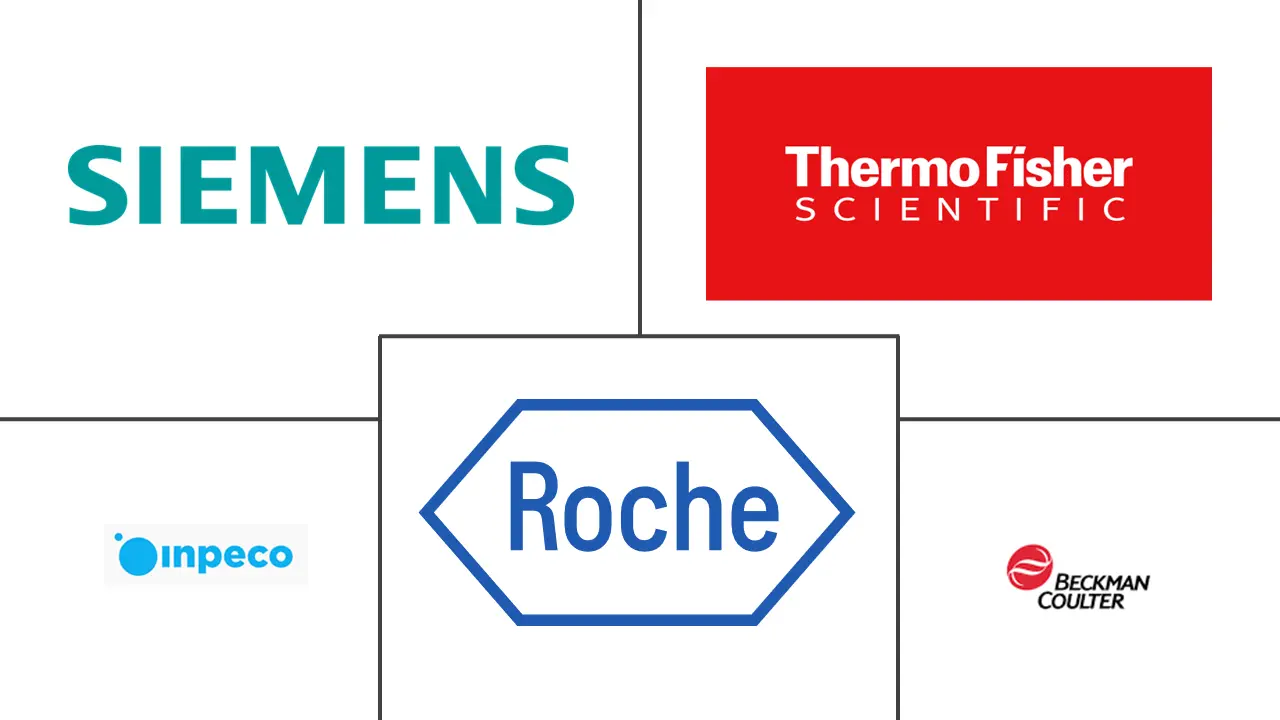Total Lab Automation Market Size and Share
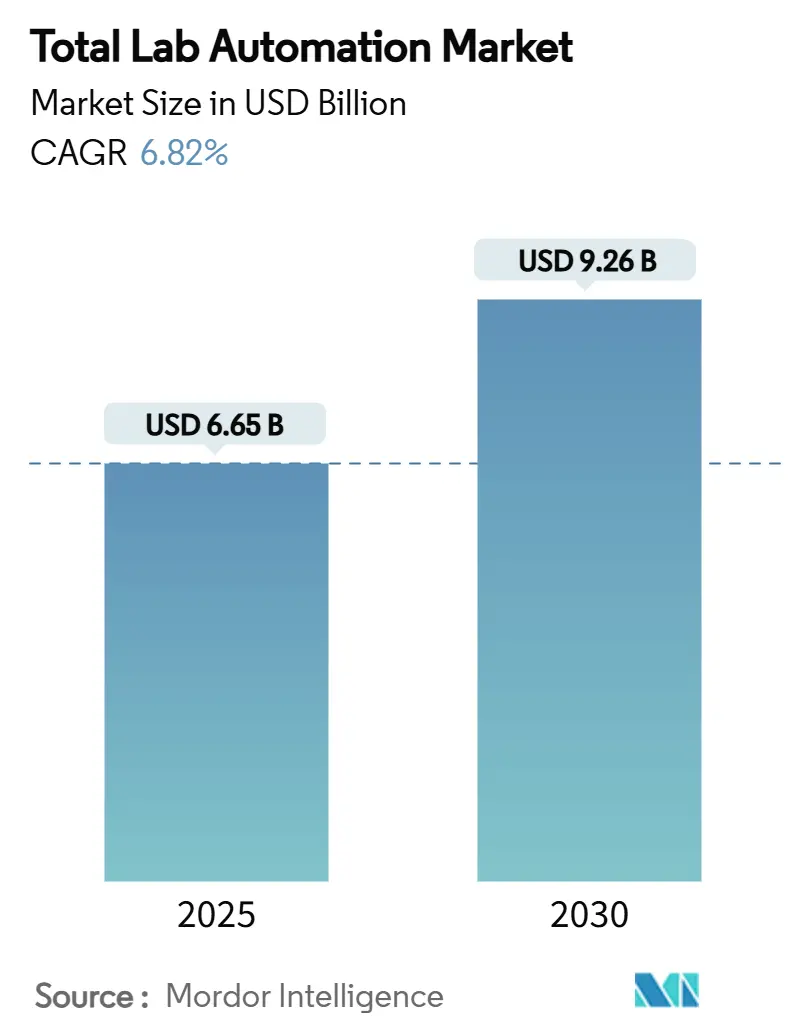
Total Lab Automation Market Analysis by Mordor Intelligence
The total lab automation market is valued at USD 6.65 billion in 2025 and is forecast to reach USD 9.26 billion by 2030, advancing at a 6.82% CAGR. This expansion is propelled by the surge in high-throughput screening for drug discovery, escalating diagnostic test volumes, and the growing priority of error minimization in clinical and research settings. Robotics, artificial intelligence, and cloud connectivity now converge in fully integrated platforms that allow laboratories to optimize workflows, predict equipment failures, and analyze large datasets in real time. The shift toward modular designs helps smaller facilities embrace automation without committing to full “islands,” while the spread of collaborative robots widens the addressable user base. Growing interest in precision medicine, stricter regulatory frameworks, and the rapid scale-up of cell and gene therapy manufacturing are also accelerating equipment upgrades and new installations across the total lab automation market.
Key Report Takeaways
- By equipment type, automated liquid handlers led with 32% of total lab automation market share in 2024, while robotic arms are projected to expand at an 8.8% CAGR through 2030.
- By software, LIMS platforms held 38% of the total lab automation market size in 2024 and SDMS solutions are advancing at a 10.2% CAGR to 2030.
- By application, clinical diagnostics accounted for 27% share of the total lab automation market size in 2024; genomics is forecast to grow at 9.5% CAGR between 2025-2030.
- By geography, North America captured 41% of total lab automation market share in 2024, whereas Asia-Pacific is on track for a 7.9% CAGR through 2030.
Global Total Lab Automation Market Trends and Insights
Drivers Impact Analysis
| DRIVER | (~) % IMPACT ON CAGR FORECAST | GEOGRAPHIC RELEVANCE | IMPACT TIMELINE |
|---|---|---|---|
| AI-enabled predictive maintenance | +1.5% | North America | Medium term (2–4 years) |
| EU IVDR upgrade cycle | +1.2% | Europe | Short term (≤ 2 years) |
| Cell and gene-therapy QC demands | +0.9% | North America and Europe | Medium term (2–4 years) |
| Decentralised trial micro-labs | +0.8% | Global | Long term (≥ 4 years) |
| Rising biobank volumes | +0.7% | Global | Medium term (2–4 years) |
| Government-funded smart hospitals | +0.6% | GCC and China | Medium term (2–4 years) |
| Source: Mordor Intelligence | |||
Integration of AI-Enabled Predictive Maintenance to Minimise Downtime
Proactive analytics now monitor temperature, pressure, vibration, and motor load across thousands of data points, spotting anomalies hours before failure. High-throughput clinical labs report up to 30% fewer unscheduled stoppages and 15-20% longer asset life after embedding these algorithms into liquid handlers and track systems. Service calls drop, reagent waste falls, and scheduling becomes more predictable, directly raising asset utilization. Vendor dashboards keep technicians informed via mobile alerts, allowing many interventions to be completed in minutes rather than hours. In North America, these gains shorten ROI cycles, making a stronger financial case for the next wave of automation upgrades.[1]Staff Reporter, “Experts See 17 Laboratory Trends Dominating 2025,” CLP Magazine, clpmag.com
EU IVDR-Driven Upgrade Cycle in Clinical Diagnostics
Europe’s shift from the IVDD to IVDR has tightened documentation, traceability, and performance evidence requirements, spurring laboratories to replace aging systems with automated solutions that log every step. Middleware now auto-generates compliance reports, reducing manual paperwork and audit risk. Vendors answer with analyzer tracks that link bar-coded tubes to cloud repositories, ensuring data integrity across pre-analytical, analytical, and post-analytical phases. As the 2028 transition milestones draw closer, procurement pipelines in Germany, France, and the United Kingdom are filling with next-generation platforms certified under the regulation. The scramble for compliant hardware and software drives short-term demand across the total lab automation market.[2]Diagnostics Press Team, “CE-IVDR Certified Transparent AI Platform for Molecular Diagnostics,” STT Info, sttinfo.fi
High-Throughput QC Needs for Cell & Gene-Therapy Manufacturing
Advanced therapies require hundreds of rapid assays for potency, purity, and identity, all under tight cold-chain conditions. Automation suppliers have responded with sterile, closed-loop robots that can pipette small-volume cell suspensions without contamination and plate stackers that maintain controlled environments. Integrated optical inspection stations check morphology in real time, cutting release times by days. Pharmaceutical sponsors now budget multi-million-dollar automation cores in every new facility, making this specialty segment a fast-rising revenue stream for the total lab automation market.[3]Pfizer Careers, “Senior Manager, Lab Robotics and Automation—Vaccines R&D,” pfizer.wd1.myworkdayjobs.com
Emergence of Decentralised & Virtual Clinical Trial Micro-Labs
Portable, benchtop analyzers combined with cloud LIMS allow trial sponsors to spin up micro-labs near patient homes, eliminating lengthy sample transport. Automated cartridge-based systems standardize preparation, and encrypted data links feed results to central statisticians in real time. This model reduces protocol deviations and improves patient retention, especially in rare-disease studies. Vendors are now packaging robotic arms, centrifuges, and bar-code readers in mobile cases that can be installed in leased storefronts or community clinics within 24 hours. Long-term, these micro-labs could shift a measurable slice of testing volume away from central reference labs and into a new adjacency of the total lab automation market.
Restraints Impact Analysis
| RESTRAINTS | (~) % IMPACT ON CAGR FORECAST | GEOGRAPHIC RELEVANCE | IMPACT TIMELINE |
|---|---|---|---|
| Seven-figure CAPEX and lengthy ROI | −1.2% | Global (higher in emerging markets) | Medium term (2–4 years) |
| Legacy middleware interoperability gaps | −0.9% | Global | Short term (≤ 2 years) |
| Cyber-security and data-sovereignty burden | −0.7% | EU and Middle East | Medium term (2–4 years) |
| Volatile precision-component supply chain | −0.5% | Global | Short term (≤ 2 years) |
| Source: Mordor Intelligence | |||
Seven-Figure CAPEX and Lengthy ROI for True TLA Islands
Comprehensive islands that unite pre-analytical, core-lab, and post-analytical stages often cost well above USD 1 million, and installation stretches past nine months. Smaller hospitals and academic labs struggle to justify outlays when annual test counts remain modest. Financing packages and pay-per-sample models are emerging but remain limited in many regions. Where budgets are approved, lengthy validation and redundancy planning delay revenue realization. This dynamic tempers near-term penetration of the most integrated formats within the total lab automation market.
Legacy Middleware Interoperability Gaps with Next-Gen Analyzers
Older middleware built on proprietary protocols cannot always handshake with REST-enabled or OPC-UA-ready analyzers, forcing costly custom coding. Each extra interface can add months and thousands of dollars to deployment, deterring some upgrades. Vendor-neutral platforms now promise drag-and-drop mapping across devices, yet certification programs remain immature. Until standards settle, integration risk continues to weigh on investment decisions in the total lab automation market.
Segment Analysis
By Equipment Type: Liquid Handlers Lead, Robotic Arms Accelerate
Automated liquid handlers generated the largest revenue slice, securing 32% of total lab automation market share in 2024. Their precise aspiration and dispensing functions underpin assay reliability across diagnostics, drug discovery, and academic research. Advanced models feature pressure-based level sensing and cross-contamination checks, reinforcing their position at the heart of high-throughput platforms. As sample counts rise in precision medicine programs, demand for faster deck configurations and on-deck incubation grows, keeping this category firmly in front of the broader total lab automation market.
Robotic arms, while a smaller base, are expanding at an 8.8% CAGR, the quickest rate among hardware lines. Compact, six-axis designs now mount inside biosafety cabinets, handing off plates between incubators, imagers, and centrifuges without human touch. New gripper technologies handle cryo-vials and cell-culture flasks, widening their scope. Collaborative variants allow technicians to teach motions manually, reducing programming overhead. Greater flexibility and falling prices together unlock adoption in mid-volume labs, adding momentum to the overall total lab automation market growth.
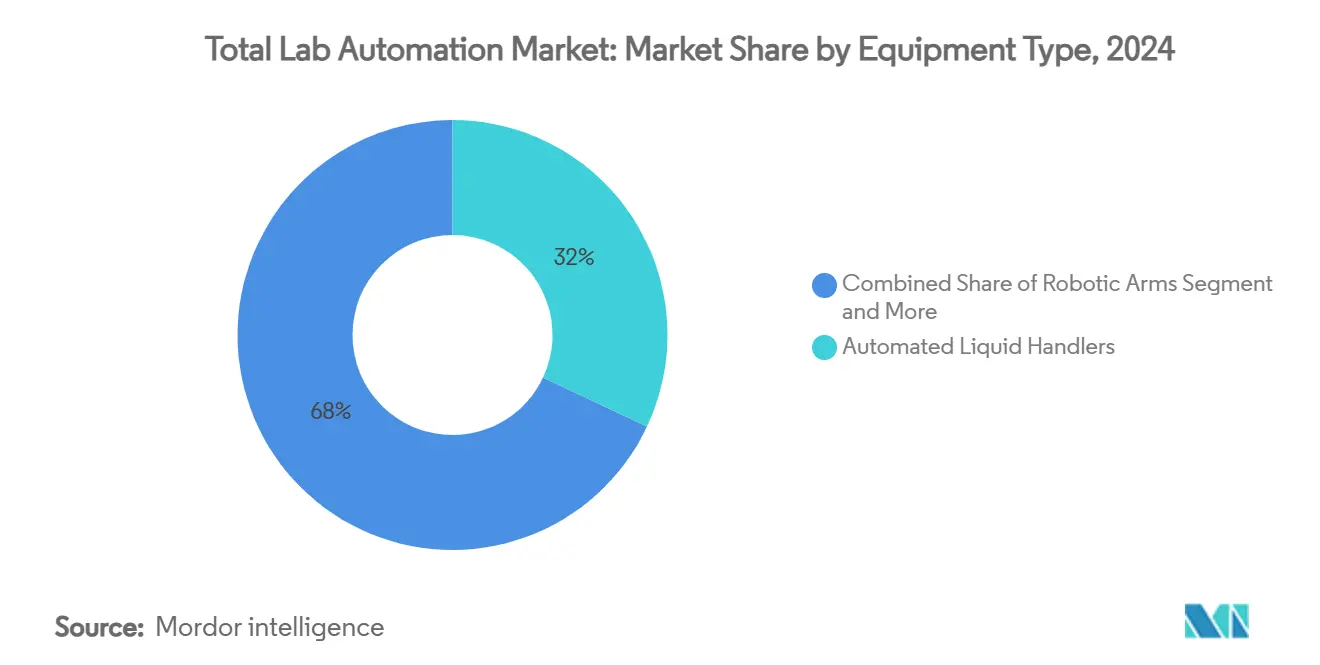
Note: Segment shares of all individual segments available upon report purchase
By Software: LIMS Dominates, SDMS Shows Fastest Growth
LIMS accounted for 38% of total lab automation market size in the software layer during 2024. Acting as an operational backbone, modern platforms manage sample accessioning, chain of custody, instrument scheduling, and regulatory reporting. Recent releases embed AI modules that flag bottlenecks and recommend recipe tweaks, transforming LIMS into real-time optimization engines rather than passive databases. Integration APIs now link directly to hospital electronic records and manufacturing execution systems, positioning LIMS as a central node in digital health infrastructure.
Scientific data management systems posted the fastest advance at 10.2% CAGR. Exploding multi-omics datasets, coupled with imaging and high-content screens, exceed the capacity of spreadsheet-based archives. SDMS solutions lever automated metadata capture, versioning, and audit trails that satisfy both regulators and research reproducibility mandates. Machine-learning extensions pull insights from raw chromatograms or gene-expression matrices in minutes, slashing time to decision. As cloud storage costs continue to fall, subscription-based SDMS uptake should remain a robust tailwind for the total lab automation market.
By Automation Scope: Analytical Automation Expands, TLA Islands Emerge
Analyzer tracks linking chemistry and immunoassay modules remain the workhorse of hospital core labs. These systems typically process thousands of tubes daily with minimal manual intervention, sustaining the largest installed base across the total lab automation market. Real-time routing rules now redirect urgent samples to STAT positions, trimming turnaround times. Meanwhile, laboratories increasingly retrofit pre-analytical robotic sorters onto existing tracks to reduce labeling errors that historically accounted for three-quarters of mistakes.
Post-analytical automation—once overlooked—is gaining traction through robotic archivers and digital result-verification engines. Total automation islands that merge all three phases into a closed loop remain scarce but are proliferating at reference laboratories where annual volumes justify capital intensity. Innovative compact footprints and modular conveyors help institutions overcome space constraints, encouraging a gradual shift toward fully integrated environments within the total lab automation market.
By Application: Clinical Diagnostics Leads, Genomics Accelerates
Clinical laboratories generated the highest contribution, holding 27% of total lab automation market size in 2024. Rising chronic disease screening, staffing shortages, and stringent quality norms sustain capital refresh cycles. AI-assisted image analysis pairs with automated staining stations, enabling quicker pathology reporting. Infectious disease panels benefit from continuous-flow PCR workcells that meter reagents with microliter precision, slashing reagent waste.
Genomics, growing at 9.5% CAGR, is the most dynamic application. Next-generation sequencers now demand automated library prep and size selection to maintain data fidelity. Robotic pipettors with HEPA-filtered enclosures mitigate contamination, while microfluidic devices miniaturize reactions, lowering per-sample cost. National precision medicine initiatives funnel grants toward genome centers, driving sustained purchase orders and reinforcing momentum of the total lab automation market.
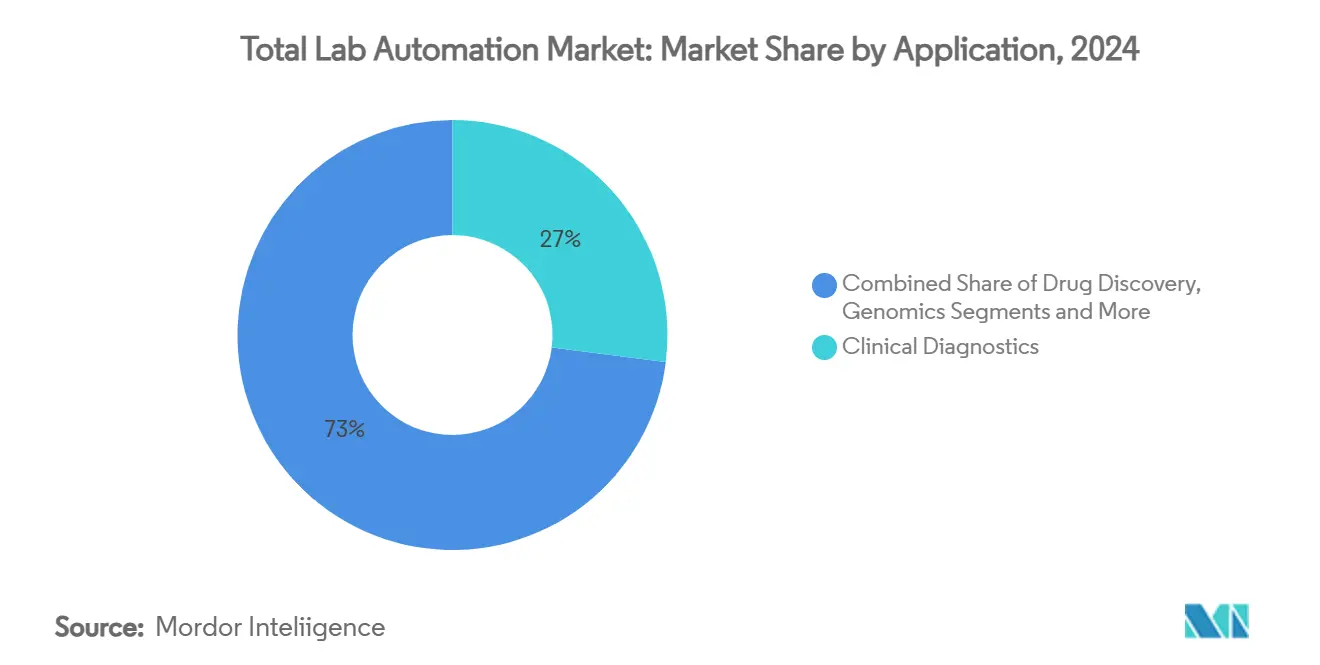
Note: Segment shares of all individual segments available upon report purchase
By End-User: Pharma & Biotech Companies Drive Adoption
Drug makers and biotechnology firms remain the largest buyers as they streamline target discovery and lead optimization. Automated label-free screening integrates AI-driven hit picking, compressing cycles by weeks. Capital budgets increasingly earmark automation for quality-by-design manufacturing, ensuring data integrity across batch records. Contract research organizations follow suit, using robotic platforms as competitive differentiators for high-volume assay services.
Hospitals and diagnostic reference labs adopt automation to cope with swelling test menus and reimbursement pressure. Integrated middleware links instruments from multiple suppliers, allowing centralized result validation. Academic and government laboratories leverage modular units to boost reproducibility and free researchers from repetitive tasks, although grant-dependent funding typically favors scalable, stepwise deployments within the total lab automation market.
Geography Analysis
North America held 41% of total lab automation market share in 2024, supported by deep clinical research budgets, large reference laboratories, and early uptake of AI predictive maintenance. Equipment vendors provide on-site analytics support, accelerating time to value. Federal initiatives encouraging real-time data exchange across care networks also reinforce adoption. Canada’s push for precision oncology and Mexico’s expanding private hospital sector add complementary tailwinds, lifting regional revenues further.
Europe ranks second, with growth shaped by the IVDR transition that forces laboratories to modernize data capture and traceability. Germany, the United Kingdom, and France spearhead installations, often integrating automation into centralized core-lab hubs that serve multiple hospitals. Public-private genomics programs call for standardized sample handling, breathing fresh life into biobanking automation. Eastern European nations, leveraging European structural funds, are now replacing legacy middleware to align with continental data-governance rules, broadening regional penetration of the total lab automation market.
Asia-Pacific is the fastest-growing territory, posting a 7.9% CAGR through 2030. China’s smart-hospital blueprints include mandated robotic tracks, spurring domestic production and joint ventures with Western suppliers. Japan emphasizes space-efficient robotics that fit cramped urban facilities, while South Korea accelerates high-throughput vaccine R&D supported by government subsidies. India sees a dual driver: global CRO investments and state-level health-scheme laboratories seeking standardized workflows. As regional supply chains mature, cost-effective platforms will likely capture incremental share across emerging Southeast Asian economies.
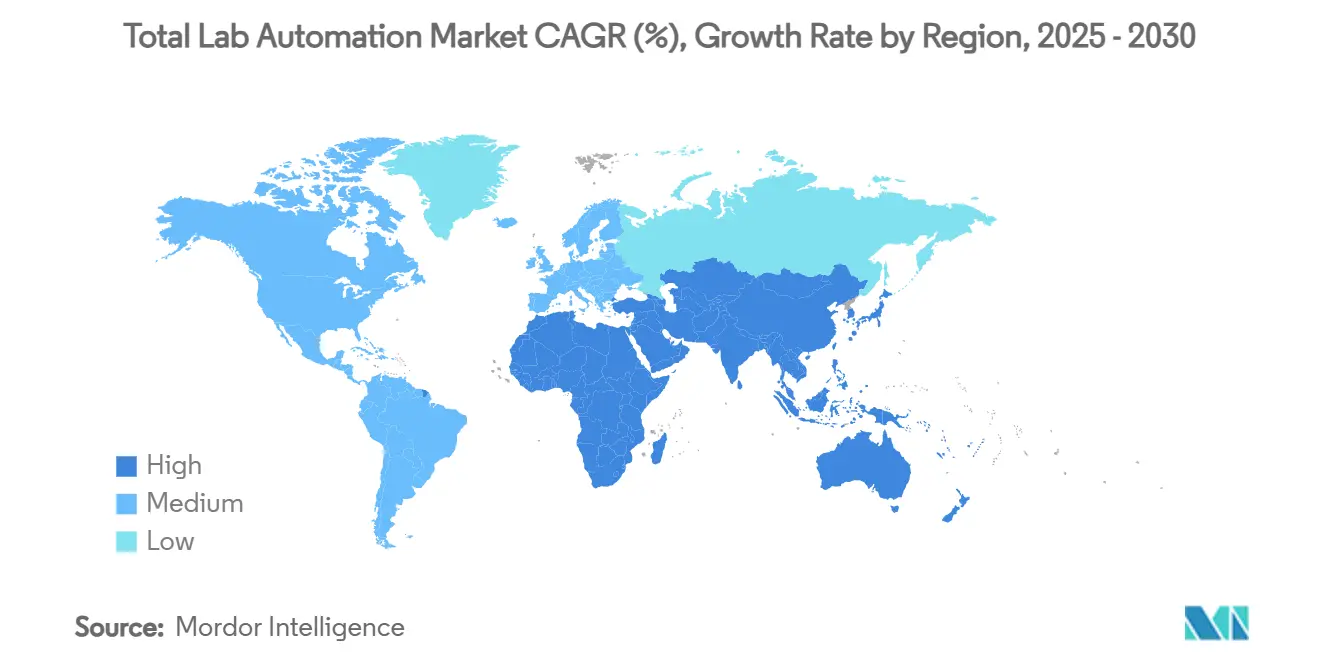
Competitive Landscape
Top manufacturers—Roche, Thermo Fisher Scientific, Beckman Coulter, Siemens Healthineers, and Abbott—collectively control about 60% of total revenues, giving the sector a moderate concentration profile. These firms bundle hardware, middleware, and service contracts into long-term agreements, embedding switching costs. Strategic acquisitions continue, particularly for AI software and cloud LIMS companies that can extend ecosystem lock-in. Joint development agreements with robotics specialists produce niche modules, such as ultra-low-volume pipetting arms for single-cell work.
At the same time, nimble disruptors push modular, low-cost robots that undercut premium incumbents. Open-source scripting and simple touchscreen interfaces help smaller labs step onto the automation ladder without heavyweight IT teams. Partnerships between storage-automation suppliers and freezer manufacturers deliver turnkey biobank solutions, blurring historical equipment silos. Cloud vendors court laboratories with pay-per-analysis bioinformatics pipelines, encouraging instrument makers to open APIs and embrace hybrid data architectures across the total lab automation market.
Service differentiation is shifting toward lifecycle analytics. Vendors now guarantee uptime percentages backed by predictive-maintenance dashboards that ship real-time logs to centralized support centers. Remote software updates roll out overnight, avoiding daytime disruptions. Sustainability also gains prominence, with new conveyor belts built from recycled alloys and power-saving eco-modes on incubators. Together, these dynamics intensify competitive positioning and push continuous innovation cycles throughout the total lab automation market.
Total Lab Automation Industry Leaders
-
Thermo Fisher Scientific Inc
-
Danaher Corporation
-
Roche Diagnostics International AG
-
Siemens Healthineers AG
-
Inpeco SA
- *Disclaimer: Major Players sorted in no particular order
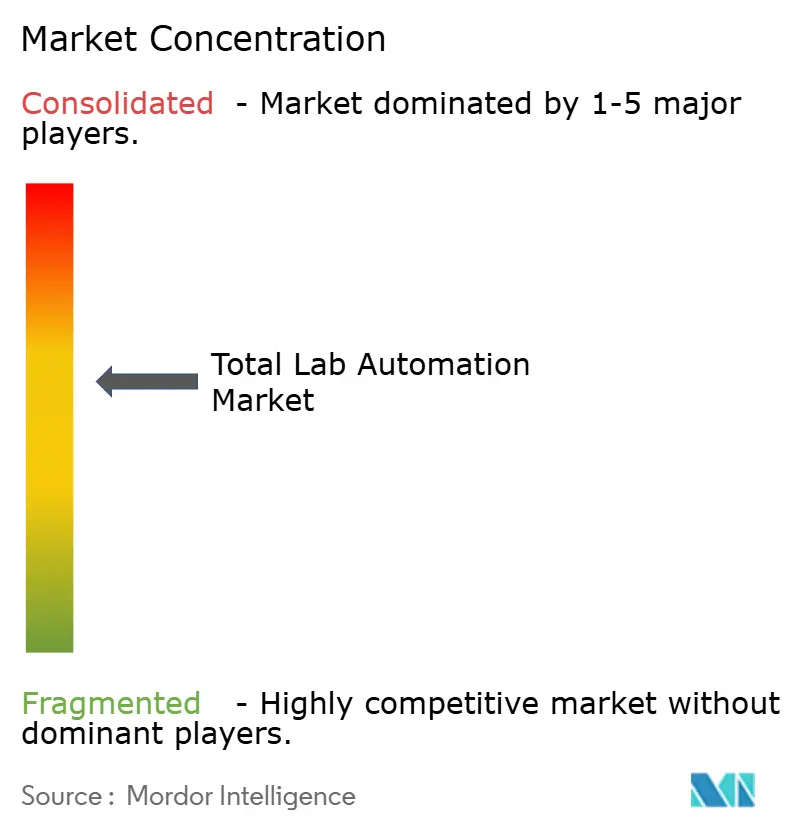
Recent Industry Developments
- May 2025: Diagnostics.ai unveiled PCR.AI, the first CE-IVDR certified transparent AI platform for molecular diagnostics, enabling laboratories to document algorithm logic for regulatory audits.
- May 2025: Beckman Coulter secured FDA clearance for the DxC 500i clinical analyzer, a compact system combining chemistry and immunoassay modules to streamline core-lab workflows.
- January 2025: Cimcorp and Murata Machinery partnered to debut dual-reach shuttles and fully automated “Dreamfield” sample warehouses, advancing high-density, refrigerated storage solutions for laboratories.
- December 2024: Thermo Fisher Scientific launched the InnoviGene Suite, automating capillary electrophoresis for genomic analysis and boosting reproducibility in precision medicine pipelines.
Global Total Lab Automation Market Report Scope
Total Laboratory Automation (TLA) is a laboratory automation system to carry out very repetitive activities. Robotic equipment is used in place of human operators to prepare and transport specimens.
The Total Lab Automation Market is segmented by Type of Equipment (automated liquid handlers, automated plate handlers, robotic arms, automated storage and retrieval systems (ASRS), and analyzers), by software (laboratory information management systems (LIMS), laboratory information system (LIS), chromatography data system (CDS), electronic lab notebook (ELN), and scientific data management system (SDMS)), by application (drug discovery, genomics, proteomics, clinical diagnostics, other applications), and by geography (North America, Europe, Asia-Pacific, and Rest of the World). The report offers market forecasts and size in value (USD) for all the above segments.
| Automated Liquid Handlers |
| Robotic Arms |
| Automated Storage and Retrieval Systems |
| Clinical Chemistry and Immuno-Analyzers |
| Automated Plate Handlers |
| Laboratory Information Management Systems (LIMS) |
| Scientific Data Management Systems (SDMS) |
| Electronic Lab Notebooks (ELN) |
| Laboratory Information Systems (LIS) |
| Chromatography Data Systems (CDS) |
| Pre-Analytical Automation |
| Analytical / Core-Lab Automation |
| Post-Analytical Automation |
| Total Lab Automation (TLA) Islands |
| Clinical Diagnostics |
| Genomics |
| Drug Discovery |
| Proteomics and Metabolomics |
| Biobank and Sample Management |
| Pharmaceutical and Biotechnology Companies |
| Contract Research and Manufacturing Organizations (CROs / CDMOs) |
| Hospitals and Diagnostic Reference Labs |
| Academic and Government Institutes |
| North America | United States |
| Canada | |
| Mexico | |
| South America | Brazil |
| Argentina | |
| Rest of South America | |
| Europe | Germany |
| United Kingdom | |
| France | |
| Italy | |
| Spain | |
| Rest of Europe | |
| Middle East | GCC |
| Turkey | |
| Rest of Middle East | |
| Africa | South Africa |
| Nigeria | |
| Rest of Africa | |
| Asia-Pacific | China |
| Japan | |
| India | |
| South Korea | |
| Southeast Asia | |
| Rest of Asia-Pacific |
| By Equipment Type | Automated Liquid Handlers | |
| Robotic Arms | ||
| Automated Storage and Retrieval Systems | ||
| Clinical Chemistry and Immuno-Analyzers | ||
| Automated Plate Handlers | ||
| By Software | Laboratory Information Management Systems (LIMS) | |
| Scientific Data Management Systems (SDMS) | ||
| Electronic Lab Notebooks (ELN) | ||
| Laboratory Information Systems (LIS) | ||
| Chromatography Data Systems (CDS) | ||
| By Automation Scope | Pre-Analytical Automation | |
| Analytical / Core-Lab Automation | ||
| Post-Analytical Automation | ||
| Total Lab Automation (TLA) Islands | ||
| By Application | Clinical Diagnostics | |
| Genomics | ||
| Drug Discovery | ||
| Proteomics and Metabolomics | ||
| Biobank and Sample Management | ||
| By End-User | Pharmaceutical and Biotechnology Companies | |
| Contract Research and Manufacturing Organizations (CROs / CDMOs) | ||
| Hospitals and Diagnostic Reference Labs | ||
| Academic and Government Institutes | ||
| By Geography | North America | United States |
| Canada | ||
| Mexico | ||
| South America | Brazil | |
| Argentina | ||
| Rest of South America | ||
| Europe | Germany | |
| United Kingdom | ||
| France | ||
| Italy | ||
| Spain | ||
| Rest of Europe | ||
| Middle East | GCC | |
| Turkey | ||
| Rest of Middle East | ||
| Africa | South Africa | |
| Nigeria | ||
| Rest of Africa | ||
| Asia-Pacific | China | |
| Japan | ||
| India | ||
| South Korea | ||
| Southeast Asia | ||
| Rest of Asia-Pacific | ||
Key Questions Answered in the Report
What is the current value of the total lab automation market?
The total lab automation market is estimated at USD 6.65 billion in 2025.
How fast is the total lab automation market expected to grow?
The market is projected to expand at a 6.82% CAGR, reaching USD 9.26 billion by 2030.
Which equipment category holds the largest total lab automation market share?
Automated liquid handlers dominate with 32% share in 2024.
Why is Asia-Pacific considered the most attractive growth region?
Asia-Pacific is forecast to post a 7.9% CAGR due to large hospital-modernization programs and expanding pharmaceutical R&D investment.
Page last updated on:
